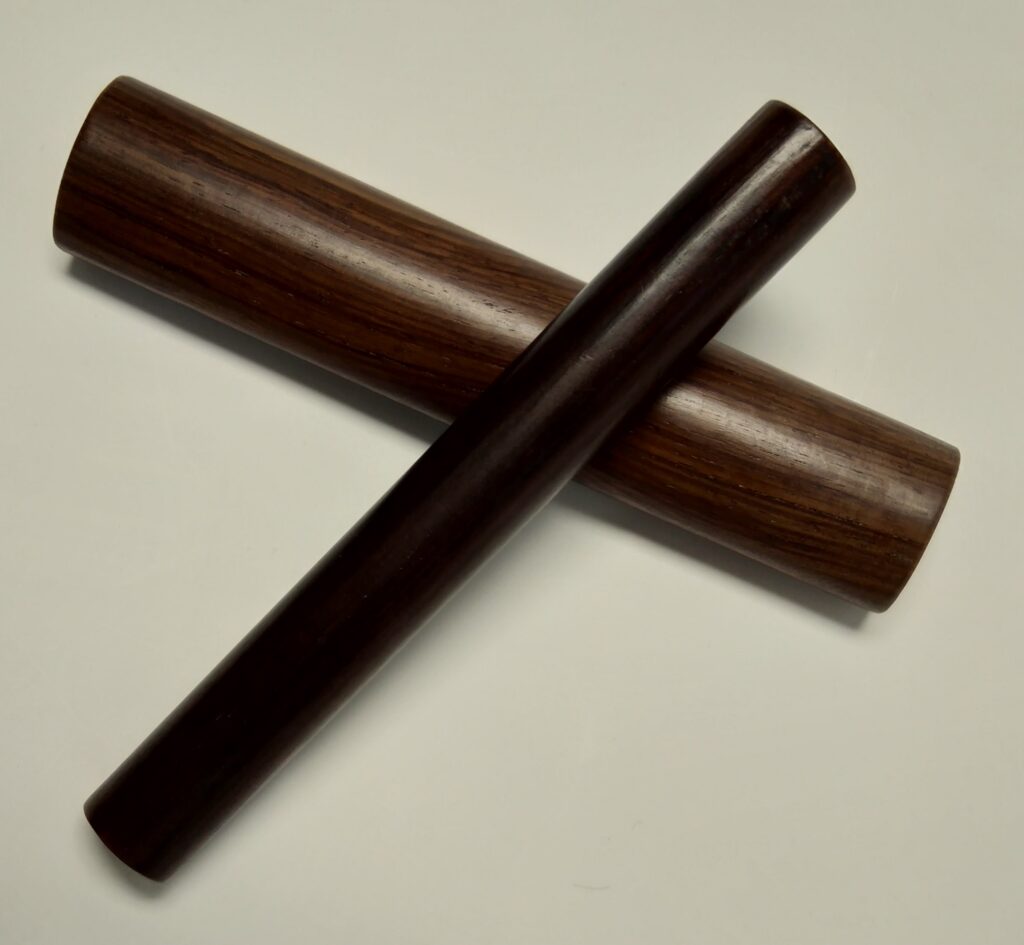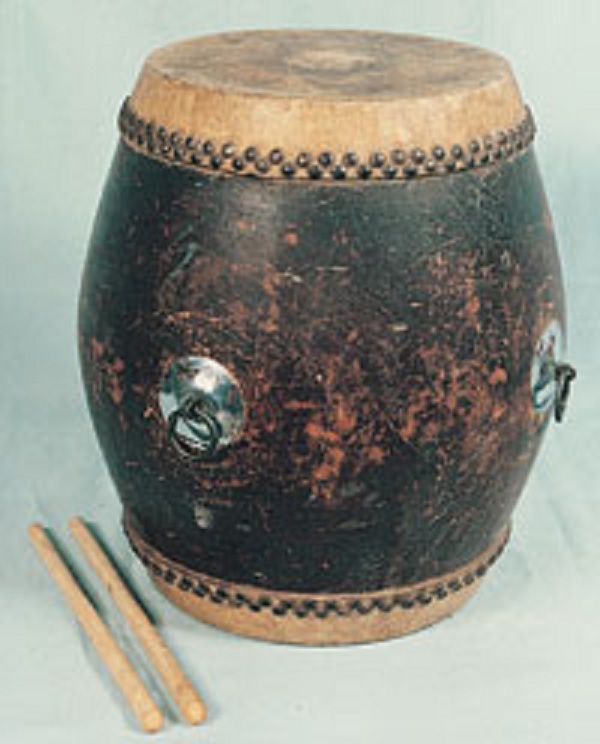中國民族音樂資料館 Chinese Music Archive

打击乐 Percussion
打击乐(皮膜类) Percussion (Leather Group)
打击乐(金属类) Percussion (Metal Group)
打击乐(竹木类) Percussion (Bamboo-Wood Group)
打击乐(皮膜类) Percussion(Leather Group)
鼓 Drum

鼓,皮面、用棰敲击。起源很早,据《礼记‧明堂位》所载,远古时候的伊耆氏已有土制的鼓。又说,夏后氏有一种足鼓。鼓在歌舞、戏曲等艺术活动中,是必不可少的伴奏乐器之一,有时还起著指挥的作用;在某些器乐合奏中亦佔有相当重要的地位并发展成为独奏乐器。今天流传的鼓,种类繁多,如:堂鼓、花盆鼓、排鼓、战鼓、手鼓、板鼓、双皮鼓、沙鼓、书鼓、渔鼓、花鼓、腰鼓、铃鼓……等等,各具特点,演奏方法也不尽相同,都有丰富的表现力
Drum, leather face percussion instrument played with a mallet. The origin is very early. Drums are one of the indispensable accompaniment instruments in singing and dancing, opera and other artistic activities, and sometimes also play the role of conductor; they also occupy a very important position in some instrumental ensembles and develop into solo instruments. There are many kinds of drums circulating today . Characteristic, playing methods are not the same, all have rich expressive power.
大鼓 Dagu/Big Drum

大鼓,桶形,中部略粗。鼓框一般用椿木、桦木、色木、杨木制造,中部设置二至四个圆形或六方形鼓泡,其上装置鼓环,用以悬挂或作提手。鼓的两面蒙以牛皮,并不涂胶鳔,由鼓钉固定。演奏时,置木架上,用两根较粗木棰敲击发音。一般鼓心发音低,鼓边发音高。奏法有单击、双击、顿击、闷击、压击、摇击、滚击等。可以独奏,亦可合奏,舞蹈伴奏及传统节日、喜庆集会等场合,更少不了它。
Big drum, barrel-shaped, slightly thick in the middle. The drum frame is generally made of different kinds of wood. Two to four round or hexagonal bubbling parts are arranged in the middle, and drum rings are installed on them to hang or serve as handles. Both sides of the drum are covered with cowhide. When playing, it is put on a wooden frame and use two thick wooden chutes to strike the sound. Generally speaking, the heart of the drum is low, and the edge of the drum is high. There are many kinds of playing methods. It can be played solo or in ensemble, dance accompaniment, traditional festivals.
堂鼓 Tanggu

堂鼓,又称同鼓,外形、制作、用材、奏法均与大鼓相同。堂鼓规格分大小,小堂鼓发音高亮,用于地方戏曲、民间舞蹈伴奏和锣鼓队中;大堂鼓音色宽厚,用于民间器乐合奏和舞蹈伴奏。演奏时,通过敲击鼓边、鼓心和控制敲击力度,能得到大幅度的音量与音色对比,渲染出不同的情绪和气氛。在十番鼓、十番锣鼓等民间器乐演奏中,由于击鼓技巧繁複,多由司板鼓者兼之。
Tanggu, also known as the Tonggu, is the same in shape, production, material and playing method as the big drum. The size of the drum is divided into sizes, and the small drum has a high-pitched sound, which is used in local opera, folk dance accompaniment and gong and drum teams; When playing, you can get a large volume and tone contrast by hitting the drum rim, drum heart and controlling the hitting intensity, rendering different moods and atmospheres
排鼓 Paigu

排鼓,是二十世纪六十年代根据民间常用的中型堂鼓和腰鼓经过不断改进创造出来的鼓类新品种。它一般由五个大小不同,从低音到高音的鼓组成一套,每个鼓的两面,外表大小一样,但内径不同,故每个鼓可发不同的两个音,通过外面的调音装置,幅度可达四或五度,故五个鼓就有十个音了。鼓身固定在一个特制的铁“U”型叉架上,中间为套管立柱,承装在支撑的三角架上,鼓身两面可随意翻转演奏。排鼓发音激烈、跳荡,高音坚实有力,中、低音宽厚宏亮,在乐队中能造成丰富的音响效果,在大型器乐合奏及鼓乐中能展现出热烈欢腾的气氛。
Paigu is a new type of drum created in the 1960s. It generally consists of five drums of different sizes, ranging from bass to treble. The two sides of each drum have the same size on the outside, but different inner diameters, so each drum can emit two different tones through the external tuning device. , the amplitude can reach four or five degrees, so five drums have ten tones. The drum body is fixed on a special iron “U”-shaped fork frame, with a casing column in the middle, which is mounted on a supporting tripod, and both sides of the drum body can be turned over and played at will. The sound of the row drum is intense and swaying, the treble is firm and powerful, and the middle and bass are generous and bright.
板鼓 Bangu

板鼓,又称班鼓、单皮,形体矮小,鼓框由五块坚厚的色木、桦木、槐木或桑木合拼制成,鼓膛呈八字形,顶端发音鼓光部位仅有5—10厘米,鼓身㡳端宽大开口,整个鼓框外部紧蒙厚猪皮或牛皮,直包至鼓身底端,用密排鼓钉绷紧,底部并箍以铁圈,故名单皮鼓。演奏时,将鼓空悬在繫有绳子的竹制或木制鼓架上,用两根鼓签敲击。板鼓分两种,鼓光大的音低,小的音高,南方十番锣鼓等用的是大鼓光,京剧和其他地方戏用的是小鼓光的板鼓。一般戏曲乐队,板鼓与柏板并用,由一人兼奏,居指挥和领奏地位。他可点签(点击鼓面)、满签(平击鼓面),又可双打(双手持签齐打或交替滚奏)、单打(右手持签击鼓、左手持拍板敲击)、闷打(左签压住鼓面,右签打鼓面,发出闷音),结合力度轻重、鼓点疏密缓急的多样变化,发挥出不同的音响效果。
Bangu, also known as bangu or single-skin, is short and small. The drum frame is made of five thick colored wood, birch, locust wood or mulberry wood. -10 cm, the drum body has a wide opening at the end, and the entire drum frame is tightly covered with thick pigskin or cowhide. It is wrapped directly to the bottom of the drum body, and is tightened with drum nails. . To play, hang the drum in the air on a bamboo or wooden drum stand tied to a rope and strike it with two drum sticks. There are two types of bangu, the louder and lower pitched drums, the southern part of China use the big drums, while the Peking Opera and other local operas use the small drums. In general opera ensembles, the bangu and the clapboard are used together, and one person plays concurrently, taking the position of conductor and lead.
铃鼓 Linggu/Tambourine

铃鼓,鼓框木制,呈扁圆形,单面蒙以羊皮、马皮或鲈皮,皮面周围用铁钉绷紧,鼓框上开有扁圆形小长孔,装置有5—7对铜或铁制的小钹,另有一个不装钹的圆孔作为手握部位。演奏时,左手持鼓,右手手指或手掌击奏,摇动鼓身,可使小钹同时作响。多用于歌唱或舞蹈伴奏,也可用于器乐合奏。
Tambourine, wooden frame, oblate, covered with sheepskin, horseskin or donkey skin on one side, and tightened with iron nails around the leather surface. The drum frame has small oblate long holes. The device has 5-7 For small cymbals made of copper or iron, there is another round hole without cymbals as the grip part. When playing, hold the drum with the left hand, and play with the fingers or palm of the right hand, and shake the drum body to make the small cymbals sound at the same time. Mostly used for singing or dancing accompaniment, but also for instrumental ensemble.
打击乐(金属类) Percussion(Metal Group)
锣 Luo/Gong

锣,铜制,圆形弧面,中央有隆起的锣光或锣脐,用布或皮条包头的锣棰敲击。唐杜佑《通典》,已提及“打沙锣”的记载,约于后魏(公元六世纪)前期开始出现。长期以来,经过不断发展,已创制出多种多样的锣类,亦有将不同音高的小锣编整成套,适于演奏旋律的 “云锣” 及大小不同音色锣群,组合成的“十面锣”和“舟山锣”。在器乐合奏,尤其锣鼓曲中,都需要用到锣。不同种类的戏曲伴奏中,所用锣类都有一定的规定。当今所用的锣类有:大锣(虎音锣)、小锣(手锣)、汤锣、鋩锣、云锣、十面锣、大抄锣、深波、风锣……等等。
Gongs, made of bronze, with a circular arc surface, played with a mallet covered by cloth or leather strap. For a long time, through continuous development, a variety of gongs have been created. There are also small gongs with different pitches arranged in sets, suitable for playing melody “cloud gongs” and gong groups of different sizes and timbres. In instrumental ensembles, especially in gongs and drums, gongs are needed. There are certain regulations for the gongs used in different types of opera accompaniment. There are many types of gongs used today.
铙、钹 Nao、Bo/Cymbal


铙(Nao)、鈸(Bo)皆响铜制成,呈圆片形,中有凸起之碗顶,每副两片,演奏时双手各执一片互击。此类乐器,先有钹,最早约出现于公元350年左右,当时称为“铜钹”;宋代才出现“铜铙”之名。明清以后,钹与铙同时并存,各有多种大小之分,名称也不统一,有谓之铙、钹、镲等。钹与铙形制虽然基本相似,但亦有分别,铙和钹中间凸起部分,大小不同,铙的小而钹的大。在音质上,铙发音较响亮,馀音较长;钹发音较浑厚,馀音较短。在音高上,以大小约同的铙、钹发音比对,钹所发的音较高。经过不断的改革和运用,钹与铙在民族管弦乐队中的作用,极为显要,在苏南吹打等民间器乐合奏,昆曲、粤剧等地方戏曲,舞龙、舞狮等民间歌舞的伴奏中,尤能发挥重要效果。
Nao and Bo are made of copper, in the shape of a disc, with a raised bowl top, two pieces in each pair, and each hand holds one piece for each other when playing. This kind of musical instrument, firstly appeared around 350 AD. After the Ming and Qing dynasties, Nao and Bo coexisted at the same time, each with a variety of sizes, and the names were not uniform. Although the shape of Nao and Bo are basically similar, there are also different in size, sound and usage.
碰铃 Pengling

碰铃,响铜制节奏乐器,又称碰钟、双磬、铃钹,古时称“星”。大约在南北朝(公元420—589年)时已有此乐器。碰铃由两个隆起碗顶的半球形铜钟以绳穿连成一套。演奏时,两手各执一枚绳端,互相碰击钟口发声。在器乐合奏、歌舞及戏曲伴奏中常用,多用于乐曲的强拍及作应节点板,无固定音高,但发音清脆悦耳,具有特殊韵味和色彩性。
Pengling, which are normally made of copper. This instrument has been around in the Southern and Northern Dynasties (AD 420-589). The bell is made up of two hemispherical bronze bells with a raised bowl top connected by a rope. When playing, hold a rope end in each hand and hit the bell mouth with each other to mak a sound. It is commonly used in instrumental ensembles, singing and dancing, and opera accompaniment. It is mostly used for strong beats and response nodes of music. There is no fixed pitch, but the pronunciation is crisp and pleasant, with special charm and color.
引磬 Yinqing

引磬,又称云磬、单子,由一个半球形黄铜钟置于一根长圆幼木柄上端。演奏时,左手执木柄的下端,右手执细长铜棍敲击。引磬发音柔和,馀韵耐听,在民族器乐小合奏中,尤特亮丽,在佛道寺庙音乐中,更是不能或缺的一员。
Yinqing, also known as cloud chime, consists of a hemispherical brass bell placed on the upper end of an oblong seedling handle. When playing, the left hand holds the lower end of the wooden handle, and the right hand holds the slender copper rod to strike. The chime has a soft and pleasant sound. It is beautiful in small ensembles of national instrumental music, and it is an indispensable member in Buddhist and Taoist temple music.
打击乐(竹木类) Percussion(Bamboo-Wood Group)
拍板 Paiban/Clapboard

拍板,由若干木块组合成套的打击乐器,多用紫檀、红木、黄杨木等木材制成,习称檀板、绰板,简称“板”。唐段安节《乐府杂录》中曾记述:“拍板本无谱,明皇遣黄幡绰造谱。”此事叙明唐代(公元618—907年)梨园已有使用拍板了。唐时,拍板大的九块,小的六块,上端用绳联成一串,下端可自由开合。演奏时,两手分执最外两块木板的下端,开合撞击中间的木板取声。发展至现代,常用于戏曲音乐和器乐合奏中,由三块板组成,常与板鼓合用,由掌板鼓手兼司。三块木板由盖板、中板和底板串合成套;中板略厚,两面是平的,盖板和底板稍薄,一面是平的,另一面隆起成脊状,盖板的平面和中板相合,用丝弦缠绕上下两端,使成一体,为一组,与另一组的单块底板,同在约向上三分二处,横开二孔,用绳或布带穿连,绳可通过扭旋调较宽紧;演奏时,左手执底板,拇指居两组中间的绳扭处,摇动手腕使底板的脊隆下部与另一组的中板下部相击取声。
Clapboard is a set of percussion instruments composed of several wooden blocks. It has developed to modern times and is often used in opera music and instrumental ensembles. It consists of three boards, often used in conjunction with the Bangu. The three wooden boards are composed of cover, middle and bottom. The plates are matched, and the upper and lower ends are wound with silk strings to form one group. It is about two-thirds upward with the single bottom plate of the other group. It can be made wider and tighter by twisting; when playing, hold the bottom plate with the left hand, place the thumb on the rope twist in the middle of the two groups, and shake the wrist so that the lower part of the ridge of the bottom plate and the lower part of the middle plate of the other group hit each other to get the sound.
梆子 Bangzi

梆子,木梆类打击乐器,又名梆板,由两根硬木梆配对组成,一为圆柱形长条,另一为长方扁圆体。明末清初时,藉著梆子腔戏曲的兴起而流行,因此梆子腔这种乱弹戏曲,以使用梆子击拍而得名。这两根木梆多採用紫檀、红木或枣木心制成,材料坚实乾透,没有疤节擘裂,外表圆弧光滑,棱角适度。演奏时,左手执长方,右手执圆柱击向长方取音,音色清脆坚实,无固定音高,是河北梆子、豫剧、秦腔等梆子戏曲的代表性打击乐器。
在中国南方,另有一种长方扁形木梆打击乐器,名为南梆子,又名卜鱼、广东板。成品是在一长方花梨木底面相对处,各挖取二分薄面的不到底长深窄缝作共鸣内腔。演奏时,左手执木梆,右手执竹签或木棰敲击开口处,又或悬于鼓架上演奏,发声短促圆润,是粤剧伴奏及广东歌乐常用的击节乐器。
Bangzi, wood percussion instrument, also known as ban board, is composed of two hardwood paired together, one is a cylindrical strip, the other is a rectangular oblate. They are mostly made of red sandalwood, mahogany or jujube wood. When playing, the left hand holds the rectangle, and the right hand holds the cylinder to strike the rectangle to obtain the sound. In southern China, there is another rectangular flat wooden percussion instrument called Nanbangzi, also known as Buyu and Cantonese board. The finished product is a rectangular rosewood bottom facing each other, and each of the two thin surfaces is dug into a long and deep narrow slit that is not at the bottom to make a resonance cavity. When performing, the left hand holds a wooden bang, and the right hand holds a bamboo or wooden stick to strike the opening, or hang it on a drum stand to play. The sound is short and mellow.
莲花板 Lianhuaban
-Bamboo-Clappers-set-1024x576.jpg)
莲花板,竹制打击乐器,由竹板与节板(碎子)组成一套,可以合用,亦可各自单独分开使用,是多种曲艺的主要伴奏乐器,常由演唱者自打自唱,以营造气氛和烘托情绪。竹板,是由两块相对较大较厚的不带竹节和无擘裂虫注的瓦形毛竹制成,上端开有两横孔,阳面相对繫以绳子作串连,下端可自由开合,一手夹击取板拍。节板,由五块或七块小竹板组成,上端开有两个横孔穿绳串连,板与板之间串夹铜钱或铜片,下端自由开合。演奏时,一手持竹板,一手持节板,碰击或摇动发音。莲花板,是快板书、山东快板、天津快板、四川金钱板等曲艺音乐的主要伴奏乐器。
Lianhuaban, a bamboo percussion instrument, is composed of 2 sets of bamboo board which can be used together or separately. One set is made of two relatively large and thick tile-shaped bamboos without bamboo joints and without cracking insects. There are two horizontal holes at the upper end, and the positive side is connected with a rope. Together, one-handed strike and take the board shot. Another set is composed of five or seven small bamboo boards. The upper end is opened with two horizontal holes and connected with ropes. Copper coins or copper sheets are sandwiched between the boards, and the lower end is free to open and close. When playing, hold the first set in one hand and another set in the other, and strike or shake the sound.
木鱼 Muyu/Wooden Fish

木鱼,木制打击乐器,原为佛教吟诵梵吹的常用乐器,后来逐渐被民间器乐合奏吸收使用。清代以来流行于民间,选材多用桑木或椿木制作,其制呈鱼形,头部正中开口,挖空腔腹,用作共鸣,尾部盘绕,其状昂首缩尾,敲击部位呈斜坡形,侧看为头大尾细的三角形,用木制棰子敲击取声。木鱼大小不一,音高不同,在民族乐队中,按七声十二律选备成套木鱼,有时还可演奏简单的独奏乐句,但一般都是使用二至三个(高中低音)作为节奏乐器或用作模仿马蹄声的音响效果。
Muyu (Wooden fish), wooden percussion instrument, was originally a common musical instrument for Buddhism activities, and was gradually absorbed and used by folk instrumental ensembles. It has been popular among the people since the Qing Dynasty. It is in the shape of a fish, with an opening in the middle of the head, hollowed out for resonance, and the tail is coiled. Viewed from the side, it is a triangle with a big head and a thin tail, and it is struck with a wooden shovel to pick up the sound. Wooden fish vary in size and pitch. In ethnic bands, a complete set of wooden fish is selected according to seven or twelve tones.


